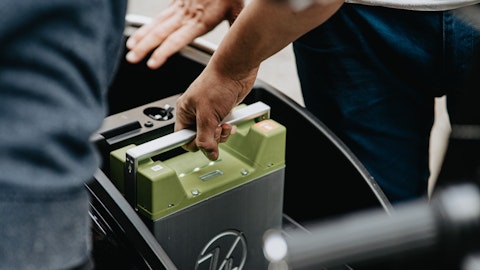Energizer Holdings, Inc. (NYSE:ENR) Q1 2024 Earnings Call Transcript February 6, 2024
Energizer Holdings, Inc. misses on earnings expectations. Reported EPS is $0.02617 EPS, expectations were $0.57. ENR isn’t one of the 30 most popular stocks among hedge funds at the end of the third quarter (see the details here).
Jon Poldan: Good morning, and Welcome to Energizer’s First Quarter Fiscal 2024 Conference Call. Joining me today are Mark LaVigne, President and Chief Executive Officer; and John Drabik, Executive Vice President and Chief Financial Officer. A replay of this call will be available on the Investor Relations section of our website, energizerholdings.com. In addition, a slide deck providing detailed financial results for the quarter is also posted on our website. During the call, we will make forward-looking statements about the Company’s future business and financial performance among other matters. These statements are based on management’s current expectations and are subject to risks and uncertainties which may cause actual results to differ materially from these statements.
We do not undertake to update these forward-looking statements. Other factors that could cause actual results to differ materially from these statements are included in reports we file with the SEC. We also refer in our presentation to non-GAAP financial measures. A reconciliation of non-GAAP financial measures to comparable GAAP measures is shown in our press release issued earlier today, which is available on our website. Information concerning our categories and estimated market share discussed on this call relates to the categories where we compete and is based on Energizer’s internal data, data from industry analysis and estimates we believe to be reasonable. The battery category information includes both brick-and-mortar and e-commerce retail sales.
Unless otherwise noted, all comments regarding the quarter and year pertain to Energizer’s fiscal year, and all comparisons to prior relate to the same period in fiscal 2023. With that, I would like to turn the call over to Mark.
Mark LaVigne: Good morning, everyone, and thank you for joining us on our fiscal 2024 first quarter earnings call. We started the fiscal year with the same priorities as we had in FY ’23, improving margins, generating free cash flow and paying down debt. In our first quarter, we delivered on our outlook and made great progress in each of these areas. Gross margin improved to 39.5% for the quarter as a result of the benefits from Project Momentum. We generated free cash flow over 21% of net sales and paid down $78 million in debt, solidifying our path to achieve below 5 times debt to EBITDA by the end of the fiscal year. In addition to the strong execution against our main priorities, we are seeing healthy indicators across our business, including an excellent response to our investments to drive improved consumer engagement without impeding margin improvement, steadily improving category trends, share gains in batteries across key customers and markets around the world, and improving consumer sentiment.
When you combine the momentum of our strategic priorities with these trends, we are positioned to deliver both top and bottom-line growth over the balance of the year. Turning to a review of the first quarter. Globally, battery category volume and value performed as expected with both down low single digit. This was largely driven by ongoing elasticity impacts from international price increases, which occurred later than in the U.S., as well as comping the energy crisis in Europe last fall, which caused a surge in category demand in our first quarter of 2023. When you narrow the view to the U.S., category volumes increased roughly 6% in the quarter. We expect international category trends to follow roughly the same recovery pattern as the U.S., as they cycle through the impact of price increases with positive global volume trends in the back half of the year.
We are achieving these results while maintaining a prudent approach to pricing and promotion. These strategically important investments have been designed to engage and bridge consumers to higher price points after multiple rounds of pricing in the category. On a year-over-year basis, the percent sold on promotion for the category was up in the quarter, but the depth of that promotion was meaningfully less than the prior year. Importantly, the investments are having the intended impact without sacrificing gross margin. We drove volume in the category and for our brands while preserving our pricing and expanding gross margin in the quarter. As we look ahead, we will be disciplined in our pricing and promotion strategies with a focus on driving the overall health of the category and our brand.
Moving to Auto Care. While the December quarter is the smallest in terms of sales for our auto business, we are entering the critical peak season with a fast start, growing organic sales by nearly 5% versus the prior year. We saw growth across three of our four subcategories, appearance, refrigerants and fragrance, and delivered double-digit growth internationally. Importantly, we are set up well to deliver low-single-digit organic growth for the full year in Auto Care, while also expanding margin. And finally, Project Momentum is delivering. The program generated over $20 million in savings in the quarter, taking total program savings to over $75 million to date. As we announced today, we continued to find areas of opportunity and we increased the total program savings target by $30 million, taking our savings range to $160 million to $180 million.

Our strong free cash flow has also been a bright spot. The combination of margin improvement and continued progress on working capital management helped to generate free cash flow of over 21% of net sales, up nearly 150 basis points from the prior year. As John will expand on in a moment, our free cash flows have allowed us to make significant progress towards reducing debt and strengthening our balance sheet. Let’s turn it over to John for more details on the quarter and the full-year outlook.
John Drabik: Thanks, Mark, and good morning, everyone. I will provide a more detailed summary of the quarter, an update on Project Momentum, and some additional color for our expectations for the rest of fiscal ’24. For the quarter, reported net sales were down 6.3% with organic revenue down 7.4%. The results for the quarter were within our initial outlook for organic sales to decline between 6% and 8%. As we called out in our last call, the largest driver of the decline was earlier holiday shipments which benefited our fourth quarter in fiscal 2023. Our sales were further impacted this quarter by continued weaker performance in non-track channels. Adjusted gross margin increased 50 basis points to 39.5%, mainly driven by Project Momentum.
Pricing was relatively flat on a year-over-year basis, but mix impacts and modestly increased product costs were slight headwinds in the quarter. Adjusted SG&A increased $3.7 million, primarily related to labor and benefit costs, as well as factoring fees in a rising rate environment, partially offset by Project Momentum savings. A&P as a percentage of sales was 6.6%, consistent with our efforts to focus investments during the critical holiday season. Interest expense decreased $2.2 million due to lower average debt outstanding as we have continued to prioritize debt paydown. As noted in our press release issued earlier this morning, we also recorded a non-cash exchange loss of $21 million in the quarter, recognizing the devaluation of the Argentine peso in December.
The devaluation was a result of broad economic reforms introduced by the newly elected administration, in which the peso was devalued by 50% in the month. Given the extraordinary nature of the devaluation, the impact was excluded from our adjusted earnings per share. We delivered adjusted EBITDA and adjusted earnings per share of $132.9 million and $0.59. We also generated $153 million of free cash flow in the quarter through a combination of margin improvement and continued progress on working capital management. We directed these strong cash flows to pay down $78 million of debt during the first quarter, and we’ve continued this progress by paying off an additional $58 million subsequent to quarter end for a total of $136 million in the first four months of the fiscal year.
Since the fourth quarter of fiscal ’22, we have paid off over $400 million of debt to date, or almost 12% of our total outstanding debt. As rates stay higher for longer, our debt capital structure remains a valuable asset as we have a weighted average cost of debt of around 4.7%, which is 94% fixed and no meaningful maturities until 2027. As Mark noted earlier, Project Momentum continues to be an important focus for us and contributed approximately $22 million of savings in the quarter. As we look forward, we’ve identified additional opportunities to drive savings, including by leveraging production assets we were able to opportunistically acquire last quarter in Belgium. Based on our latest estimates, we are calling up our full program outlook by $30 million for total program savings of $160 million to $180 million.
We also expect onetime cash costs for the program to run at roughly 80% to 90% of the projected savings. And finally, I would like to provide some additional color on our outlook for the remainder of the year. For the second quarter, we expect organic net sales to be down between 2% and 3% as we cycle through softness in non-track channels. We also anticipate gross margin in the quarter to improve by 150 basis points year-over-year, and for adjusted EPS to be in the range of $0.65 to $0.70, up mid-single digits at the midpoint versus the same quarter in the prior year. Over the back half of the year, we expect to return to top line growth driven by a few key factors. First, we expect volumes to continue to improve in the category as consumers adjust to the pricing taken over the previous two years, especially in international markets where pricing actions occurred later than in the U.S. We also expect a recovery in some of the non-track channels, which should begin to comp large declines that began last spring.
And finally, we expect distribution wins across both Battery and Auto to help drive back half sales. For the full fiscal year, we continue to expect Project Momentum savings of $55 million to $65 million. We also expect to pay down $150 million to $200 million of debt for the year, and to end fiscal ’24 below 5 times leverage. We are reaffirming our outlook for organic net sales to be flat to down 2%, adjusted gross margin improvement of 100 basis points with improvement across both Battery and Auto Care, adjusted EBITDA in the range of $600 million to $620 million, and adjusted earnings per share of $3.10 to $3.30. With that, I’ll turn it back over to Mark for closing remarks.
Mark LaVigne: In summary, our first quarter performance sets us up well for the remainder of the year. We have the flexibility and discipline to navigate the market condition, particularly in light of the strong momentum across our cost savings and cash generation initiatives. We will remain laser-focused on delivering growth, advancing our strategic priorities, and delivering shareholder value. Now, let’s open the call for questions.
See also 10 Best Cheap Car Insurance in New Jersey for 2024 and 17 Deadliest And Most Common Cancers In The world.
Q&A Session
Follow Energizer Holdings Inc. (NYSE:ENR)
Follow Energizer Holdings Inc. (NYSE:ENR)
Operator: [Operator Instructions] And our first question comes from the line of Lauren Lieberman at Barclays. Please go ahead. Your line is open.
Lauren Lieberman: Great. Thanks so much. And the first thing I was hoping is if you could just tell us a little bit more about the Belgium facility you acquired and kind know just anything you can offer on that, and how much of that was really what was driving the uptick in momentum savings. Or is that something that still maybe more to be evaluated as we move forward?
Mark LaVigne: Lauren, we continue to evaluate Project Momentum, and as you’ve seen, as we’ve gotten further in the program, we’ve been able to take the ranges up 160 to 180 is our current call based on everything we know today, including the acquisition of the Belgium facility. And that was an opportunistic opportunity that came across late last year. It allows us to pivot and do in region for region manufacturing. It’s driving great working capital improvements, cost savings improvements, and it was a relatively low-level investment. You know, the purchase price for the assets was roughly €3.5 million.
Lauren Lieberman: Great. That’s fantastic. Thank you. And then just on Auto Care, and constructive commentary on top line, but margins did take a step back this quarter. So just kind of curious about anything that was discreet to the quarter and how we should be thinking about kind of gross margin opportunity for the full year.
Mark LaVigne: Yes. I would say, Lauren, the first quarter was not reflective of what we expect for the full year. We’re still anticipating gross margin improvement as we go throughout the year, pretty significant and that should help us deliver bottom-line performance on a segment profit perspective as well.
Lauren Lieberman: Okay. And is there anything within there that I guess, I’m sure it’s still partially Project Momentum, but like operational changes that are being made in Auto versus raw mats and pricing kind of stuff? I’m curious about what’s sort of in your control versus the macro if you will.
Mark LaVigne: Yes. No. No, no. It’s obviously, the smallest quarter by far. So when you kind of come into the year and look at re-rolling standards, you got some indirect costs that you allocate to the business. It’s really not reflective of the full-year run rate.
John Drabik: And Lauren, just to build on that, I think from a gross margin standpoint in Auto Care, we’re expecting improvement this year. And then I think one of the questions that’s out there is when will we get that business back to where we were when we acquired it, and our anticipation is with continued gross margin improvement, including a lot of the plans we have under Project Momentum is we’ll achieve that level in ’25.
Lauren Lieberman: All right. Thanks. I’ll pass it on and come back on.
Mark LaVigne: Yes. Thanks, Lauren.
Operator: Thank you. Our next question comes from the line of Bill Chappell at Truist Securities. Please go ahead. Your line is open.
Bill Chappell: Thanks. Good morning,
Mark LaVigne: Good Morning, Bill.
John Drabik: Good Morning, Bill.
Bill Chappell: So talking a little bit more about your kind of commentary or maybe your visibility into battery volumes picking up, and I’m just trying to understand kind of elasticity commentary in terms of the business has always been kind of impulse/commodity in terms of you and Duracell are line-priced. You haven’t seen Rayovac really pick up in share, even though it’s a lower-priced product or private label. So try and understand how consumers adjust if they haven’t already and volumes start to pick back up? Or is it more — or if there’s something else I’m missing?
Mark LaVigne: No Bill. Let me start. So I would say from an overall standpoint on the category, let me — we really like where we are from category trends. I think we’re positioned very well to deliver the year. Let me start by kind of breaking it down on the component parts of the overall category. And this is — so in the U.S., when you talk track channels, volume is consistently improving. You saw us go from kind of down high single digits, down 1.5% year-over-year, and then the latest numbers have been down 0.5% in volume, and even the numbers that came out this morning were positive. So you are seeing that inflection point in track channels to positive volume growth. That’s a great sign in terms of working through the elasticity impacts, working through the pandemic surge in demand, and all of the factors that have gone into that.
Then you break it down into sort of the online channel, both pure play as well as omni, that’s been a consistent source of growth over the last couple of quarters and would continue — we’d expect that to continue. Then when you get into non-track channels with home center and OEM, we expect those trends to stabilize. If you recall, it was kind of last April-May when we saw some of the declines that we saw in-home center. We expect to work our way through those. So those trends should stabilize. International, you have elasticity impacts from pricing which occurred later in the U.S. We expect to work through those. We’re already seeing signs as you are Latin America, Asia Pacific in particular. In Europe, you had a bit of an anomaly with the energy crisis there last year.
So all in all, those trends are positive just from a category standpoint. And then specific to our business, on top of just basic execution, we are seeing some distribution wins in both batteries as well as an auto, which we expect to take hold in the back half of the year. So all of those factors, both from a category as well as our business specifically, give us great confidence in the back half of the year returning to growth.


